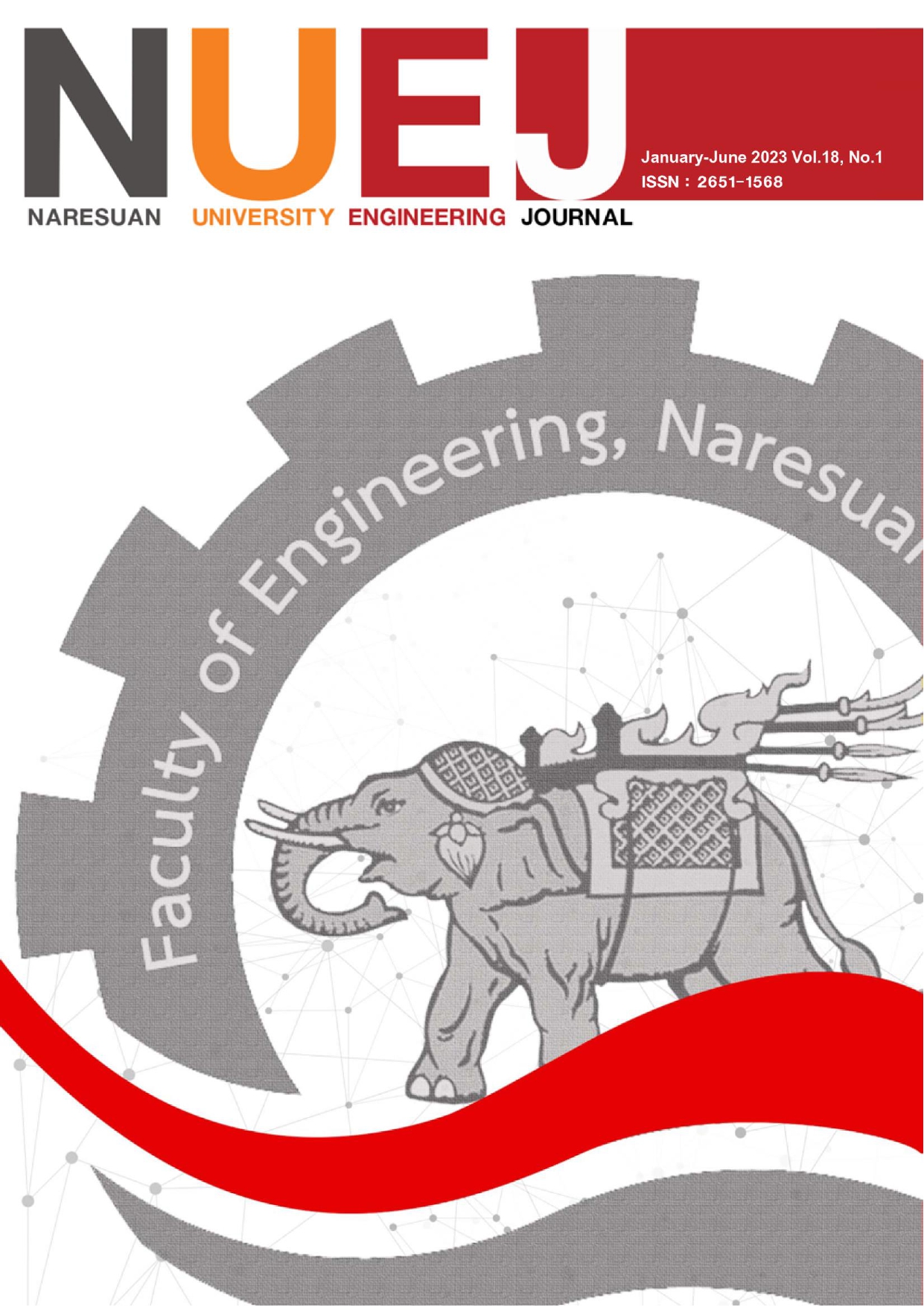Autobody Spot-Welding Optimization Based on Genetic Algorithm (GA)
Main Article Content
Abstract
Resistance Spot Welding (RSW) is an important technology that has extensively been applied in the automotive industry. The advantages of this technology are quick and efficient for joining two pieces of metal together. The minimum number of spot welds without decreasing strength has gained much attention from researchers in recent years. In this research, the finite element (FEM) method and the Genetic Algorithm (GA) were proposed to optimize the Spot-welding spacing on automotive aluminum alloy parts. The simulation model was developed to analyze the von Mises stress generated by the side collision on the parts. According to the Insurance Institute for Highway Safety (IIHS) collision test, the computational experiment was designed that the diameter of the steel pipe 180 millimeters perpendicularly collided with the workpiece at the velocity of 14 meters per second to study the maximum stress of the workpiece. This numerical simulation cooperated with the GA for optimizing the spot-welding spacing under the lowest von Mises stress distribution criteria. From the experimental results, it was found that The GA presented the optimal spot-weld spacing on an automotive part. It could reduce the number of spot welds, weld belong-time, and power consumption by 10%. These results demonstrate that the proposed GA is a promising approach for the spot-weld spacing optimization for the Automotive part.
Article Details

This work is licensed under a Creative Commons Attribution-NonCommercial-NoDerivatives 4.0 International License.
References
Al-Mukhtar, A., & Doos, Q. (2013). The Spot Weldability of Carbon Steel Sheet. Advances in Materials Science and Engineering, 2013, 1-6. doi:10.1155/2013/146896
Ambroziak, A., & Korzeniowski, M. (2010). Using Resistance Spot Welding for Joining Aluminium Elements in Automotive Industry. Archives of Civil and Mechanical Engineering, 10, 5–13. doi:10.1016/S1644-9665(12)60126-5
Chae, S.-W., Kwon, K.-Y., & Lee, T.-S. (2002). An optimal design system for spot welding locations. Finite Elements in Analysis and Design, 38(3), 277-294. doi:https://doi.org/10.1016/S0168-874X(01)00064-6
Ertas, A.H. & Sonmez, F.O. (2008). Optimization of spot-weld joints. Proceedings of the Institution of Mechanical Engineers, Part C: Journal of Mechanical Engineering Science, 223(3), 545-555. doi:10.1243/09544062JMES1171
Ertas, A.H. & Sonmez, F.O. (2011). Design optimization of spot-welded plates for maximum fatigue life. Finite Elements in Analysis and Design, 47(4), 413-423. doi:https://doi.org/10.1016/j.finel.2010.11.003
Gatzi, R., Uebersax, M., & Konig, O. (2000). Structural Optimization Tool using Genetic Algorithms and Ansys.
Geißler, G. & Hahn, T. (2011 ). Process development for multi-discriplinary spot weld optimization with CAX-LOCO, LS-OPT and ANSA. Paper presented at the ANSA & μETA International Conference, Makedonia Palace, Thessaloniki, Greece.
Gould, B. (2012). Joining Aluminum Sheet in the Automotive Industry – A 30 Year History Resistance welding , mechanical fasteners , and ultrasonic welding are examined in this overview of joining technology.
Hasegawa, H., Sasaki, H., Uehara, H., & Kawamo, K. (2007). The optimisation of spot-weld positions for vehicle design by using hybrid meta-heuristics. International Journal of Vehicle Design - INT J VEH DES, 43. doi:10.1504/IJVD.2007.012301
Hu, J., Bi, J., Liu, H., Li, Y., Ao, S., & Luo, Z. (2022). Prediction of Resistance Spot Welding Quality Based on BPNN Optimized by Improved Sparrow Search Algorithm. Materials, 15(20), 7323.
Jones, D. F., Mirrazavi, S. K., & Tamiz, M. (2002). Multi-objective meta-heuristics: An overview of the current state-of-the-art. European Journal of Operational Research, 137(1), 1-9. doi:https://doi.org/10.1016/S0377-2217(01)00123-0
Kemda, F., Barka, B.V. Jahazi, M & Osmani, D. (2022). Multi-Objective Optimization of Process Parameters in Resistance Spot Welding of A36 Mild Steel and Hot Dipped Galvanized Steel Sheets Using Non-dominated Sorting Genetic Algorithm. Metals and Materials International, 28(2), 487-502. doi:10.1007/s12540-021-00986-9
Mali, M. P., & Inamdar, K. (2013). EFFECT OF SPOT WELD POSITION VARIATION ON QUALITY OF AUTOMOBILE SHEET METAL PARTS. International Journal of Applied Research in Mechanical Engineering, 170-174. doi:10.47893/IJARME.2013.1081
Montgomery, D. C. (2012). Design and Analysis of Experiments, 8th Edition: John Wiley & Sons, Incorporated.
Pashazadeh, H., Gheisari, Y., & Hamedi, M. (2016). Statistical modeling and optimization of resistance spot welding process parameters using neural networks and multi-objective genetic algorithm. Journal of Intelligent Manufacturing, 27(3), 549-559. doi:10.1007/s10845-014-0891-x
Salem, M. (2011). Control and Power Supply for Resistance Spot Welding (RSW). (Graduate Program in Electrical and Computer Engineering), The University of Western Ontario,
Tabar, R. S., Wärmefjord, K., & Söderberg, R. (2018). Evaluating evolutionary algorithms on spot welding sequence optimization with respect to geometrical variation. Procedia CIRP, 75, 421-426. doi:https://doi.org/10.1016/j.procir.2018.04.061
Talbi, E.-G. (2009). Metaheuristics: From Design to Implementation: WILEY.
Wang, L., Basu, P., & Leiva, J. (2003). Design optimisation of automobile welds. International Journal of Vehicle Design - INT J VEH DES, 31. doi:10.1504 /IJVD. 2003. 00 3352
Zhang, Y., & Taylor, D. (2001). Optimization of spot-welded structures. Finite Elements in Analysis and Design, 37, 1013-1022. doi:10.1016/ S0168-874X(01)00046-4
Zhao, F., Li, S., Sun, J., & Mei, D. (2009). Genetic algorithm for the one-commodity pickup-and-delivery traveling salesman problem. Computers & Industrial Engineering, 56(4), 1642-1648. doi:https://doi.org/10.1016/j.cie.2008.10.014


